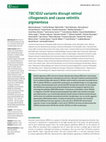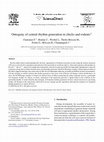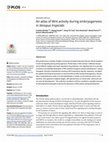Papers by Caroline Borday
bioRxiv (Cold Spring Harbor Laboratory), Jul 26, 2017
PFKFB4 controls neural crest final specification and migration by regulation of AKT signaling or ... more PFKFB4 controls neural crest final specification and migration by regulation of AKT signaling or glycolysis.

JCI Insight
Retinitis pigmentosa (RP) is the most common inherited retinal disease (IRD) and is characterized... more Retinitis pigmentosa (RP) is the most common inherited retinal disease (IRD) and is characterized by photoreceptor degeneration and progressive vision loss. We report 4 patients presenting with RP from 3 unrelated families with variants in TBC1D32, which to date has never been associated with an IRD. To validate TBC1D32 as a putative RP causative gene, we combined Xenopus in vivo approaches and human induced pluripotent stem cell-derived (iPSC-derived) retinal models. Our data showed that TBC1D32 was expressed during retinal development and that it played an important role in retinal pigment epithelium (RPE) differentiation. Furthermore, we identified a role for TBC1D32 in ciliogenesis of the RPE. We demonstrated elongated ciliary defects that resulted in disrupted apical tight junctions, loss of functionality (delayed retinoid cycling and altered secretion balance), and the onset of an epithelial-mesenchymal transition-like phenotype. Last, our results suggested photoreceptor differentiation defects, including connecting cilium anomalies, that resulted in impaired trafficking to the outer segment in cones and rods in TBC1D32 iPSC-derived retinal organoids. Overall, our data highlight a critical role for TBC1D32 in the retina and demonstrate that TBC1D32 mutations lead to RP. We thus identify TBC1D32 as an IRD-causative gene.

Respiratory Physiology & Neurobiology, Nov 1, 2006
Recent studies help in understanding how the basic organization of brainstem neuronal circuits al... more Recent studies help in understanding how the basic organization of brainstem neuronal circuits along the anterior-posterior (AP) axis is set by the Hox-dependent segmentation of the neural tube in vertebrate embryos. Neonatal respiratory abnormalities in Krox20 −/− , Hoxa1 −/− and kreisler mutant mice indicate the vital role of a para-facial (Krox20-dependent, rhombomere 4-derived) respiratory group, that is distinct from the more caudal rhythm generator called Pre-Bötzinger complex. Embryological studies in the chick suggest homology and conservation of this Krox20-dependent induction of parafacial rhythms in birds and mammals. Calcium imaging in embryo indicate that rhythm generators may derive from different cell lineages within rhombomeres. In mice, the Pre-Bötzinger complex is found to be distinct from oscillators producing the earliest neuronal activity, a primordial low-frequency rhythm. In contrast, in chicks, maturation of the parafacial generator is tightly linked to the evolution of this primordial rhythm. It seems therefore that ontogeny of brainstem rhythm generation involves conserved processes specifying distinct AP domains in the neural tube, followed by diverse, lineage-specific regulations allowing the emergence of organized rhythm generators at a given AP level.

Development, 2017
Neural crest (NC) specification comprises an early phase, initiating immature NC progenitors form... more Neural crest (NC) specification comprises an early phase, initiating immature NC progenitors formation at neural plate stage, and a later phase at neural fold stage, resulting in a functional premigratory NC that is able to delaminate and migrate. We found that the NC gene regulatory network triggers upregulation of pfkfb4 (6-phosphofructo-2-kinase/fructose-2,6-bisphosphatase 4) during this late specification phase. As shown in previous studies, PFKFB4 controls AKT signaling in gastrulas and glycolysis rate in adult cells. Here, we focus on PFKFB4 function in NC during and after neurulation, using timecontrolled or hypomorph depletions in vivo. We find that PFKFB4 is essential both for specification of functional premigratory NC and for its migration. PFKFB4-depleted embryos fail to activate n-cadherin and late NC specifiers, and exhibit severe migration defects resulting in craniofacial defects. AKT signaling mediates PFKFB4 function in NC late specification, whereas both AKT signaling and glycolysis regulate migration. These findings highlight novel and essential roles of PFKFB4 activity in later stages of NC development that are wired into the NC gene regulatory network.
Basic and clinical andrology, Dec 1, 2013

PLOS ONE, Apr 19, 2018
Wnt proteins form a family of highly conserved secreted molecules that are critical mediators of ... more Wnt proteins form a family of highly conserved secreted molecules that are critical mediators of cell-cell signaling during embryogenesis. Partial data on Wnt activity in different tissues and at different stages have been reported in frog embryos. Our objective here is to provide a coherent and detailed description of Wnt activity throughout embryo development. Using a transgenic Xenopus tropicalis line carrying a Wnt-responsive reporter sequence, we depict the spatial and temporal dynamics of canonical Wnt activity during embryogenesis. We provide a comprehensive series of in situ hybridization in whole-mount embryos and in crosssections, from gastrula to tadpole stages, with special focus on neural tube, retina and neural crest cell development. This collection of patterns will thus constitute a valuable resource for developmental biologists to picture the dynamics of Wnt activity during development.
Journal of Physiology-paris, Nov 1, 2006
Studies of the sites and mechanisms involved in mammalian respiratory rhythm generation point to ... more Studies of the sites and mechanisms involved in mammalian respiratory rhythm generation point to two clusters of rhythmic neurons forming a coupled oscillator network within the brainstem. The location of these oscillators, the pre-Bötzinger complex (preBötC) at vagal level, and the para-facial respiratory group at facial level, probably result from regional patterning schemes specifying neural types in the hindbrain during embryogenesis. Here, we report evidence that the preBötC oscillator (i) is first active at embryonic stages, (ii) originates in the post-otic hindbrain neural tube and (iii) requires the glutamate vesicular transporter 2 for rhythm generation.

Respiratory Physiology & Neurobiology, May 1, 2003
The present paper presents some of the molecular switches that may operate at early embryonic sta... more The present paper presents some of the molecular switches that may operate at early embryonic stages to make development of the brainstem respiratory rhythm generator a robust and irreversible process. We concentrate on the role of transient Hox-related gene expression patterns in register with the regionalisation of the rhombencephalic neural tube along the antero-posterior axis. Using different recording and isolation procedures in chick embryos, we show that the hindbrain is subdivided at E1 into developmental units (rhombomeres) intrinsically able to produce rhythm generating neuronal circuits active at E5. At E6, intrinsic cues also allow a progressive maturation of episodic rhythm generators that persists after isolation of the hindbrain in vitro and requires odd/even rhombomeric interactions at E1. From these results and from respiratory pathologies observed in transgenic mice, we are beginning to understand that, despite diversity of breathing patterns and adaptations, there are links between developmental control genes and adult respiration.

Respiratory Physiology & Neurobiology, Nov 1, 2005
Recent data begin to bridge the gap between developmental events controlling hindbrain neural tub... more Recent data begin to bridge the gap between developmental events controlling hindbrain neural tube regional patterning and the emergence of breathing behaviour in the fetus and its vital adaptive function after birth. In vertebrates, Hox paralogs and Hoxregulating genes orchestrate, in a conserved manner, the transient formation of developmental compartments in the hindbrain, the rhombomeres, in which rhythmic neuronal networks of the brainstem develop. Genetic inactivation of some of these genes in mice leads to pathological breathing at birth pointing to the vital importance of rhombomere 3 and 4 derived territories for maintenance of the breathing frequency. In chick embryo at E7, we investigated neuronal activities generated in neural tube islands deriving from combinations of rhombomeres isolated at embryonic day E1.5. Using a gain of function approach, we reveal a role of the transcription factor Krox20, specifying rhombomeres 3 and 5, in inducing a rhythm generator at the parafacial level of the hindbrain. The developmental genes selecting and regionally coordinating the fate of CNS progenitors may hold further clues to conserved aspects of neuronal network formation and function. However, the most immediate concern is to take advantage of early generated rhythmic activities in the hindbrain to pursue their downstream cellular and molecular targets, for it seems likely that it will be here that rhythmogenic properties will eventually take on a vital role at birth.

Progress in Biophysics & Molecular Biology, Feb 1, 2004
The respiratory rhythm is generated within the hindbrain reticular formation, rostrally in the vi... more The respiratory rhythm is generated within the hindbrain reticular formation, rostrally in the vicinity of the facial nucleus and caudally within the vagal/glossopharyngeal domain. This is probably one of the best models to understand how genes have been selected and conserved to control adaptive behaviour in vertebrates. The para-facial region is well understood with respect to the transcription factors that underlie antero-posterior specification of neural progenitors in the embryo. Hox paralogs and Hox-regulating genes kreisler and Krox-20 govern transient formation of developmental compartments, the rhombomeres, in which rhythmic neuronal networks develop. Hox are master genes selecting and coordinating the developmental fate of reticular and motor neurons thereby specifying patterns of motor activities operating throughout life. Neuronal function and development are also tightly linked in the vagal/glossopharyngeal domain. At this level, bdnf acts as a neurotrophin of peripheral chemoafferent neural populations and as a neuromodulator of the central rhythmogenic respiratory circuits. A general view is now emerging on the role of developmental transcription and trophic factors allowing the coordinated integration of different neuronal types to produce, and eventually refine, respiratory rhythmic pattern in a use-dependent manner.
HAL (Le Centre pour la Communication Scientifique Directe), 2004
Springer eBooks, 2004
ABSTRACT Respiration is a rhythmic motor behavior that appears in the fetus and acquires a vital ... more ABSTRACT Respiration is a rhythmic motor behavior that appears in the fetus and acquires a vital importance at birth. It is generated centrally, within neuronal networks of the brainstem. Recently, examination of hindbrain activities in the embryo has revealed that a central rhythm generator is active in the brainstem before fetal maturation and conforms to the segmented organization of the embryonic hindbrain at this stage of development. From physiological studies of this primordial rhythm generator in embryos, we may therefore gain an understanding of how genes govern development of neuronal networks and specify patterns of motor activities operating throughout life.

Journal of Neurobiology, 2006
How regional patterning of the neural tube in vertebrate embryos may influence the emergence and ... more How regional patterning of the neural tube in vertebrate embryos may influence the emergence and the function of neural networks remains elusive. We have begun to address this issue in the embryonic mouse hindbrain by studying rhythmogenic properties of different neural tube segments. We have isolated pre- and post-otic hindbrain segments and spinal segments of the mouse neural tube, when they form at embryonic day (E) 9, and grafted them into the same positions in stage-matched chick hosts. Three days after grafting, in vitro recordings of the activity in the cranial nerves exiting the grafts indicate that a high frequency (HF) rhythm (order: 10 bursts/min) is generated in post-otic segments while more anterior pre-otic and more posterior spinal territories generate a low frequency (LF) rhythm (order: 1 burst/min). Comparison with homo-specific grafting of corresponding chick segments points to conservation in mouse and chick of the link between the patterning of activities and the axial origin of the hindbrain segment. This HF rhythm is reminiscent of the respiratory rhythm known to appear at E15 in mice. We also report on pre-/post-otic interactions. The pre-otic rhombomere 5 prevents the emergence of the HF rhythm at E12. Although the nature of the interaction with r5 remains obscure, we propose that ontogeny of fetal-like respiratory circuits relies on: (i) a selective developmental program enforcing HF rhythm generation, already set at E9 in post-otic segments, and (ii) trans-segmental interactions with pre-otic territories that may control the time when this rhythm appears.

Regenerative abilities are not evenly distributed across the animal kingdom. Interestingly, the u... more Regenerative abilities are not evenly distributed across the animal kingdom. Interestingly, the underlying modalities are also highly variable, even among closely related species. In fish or amphibians, retinal repair can involve the mobilization of different cellular sources, including stem cells of the ciliary marginal zone (CMZ), retinal pigmented epithelial (RPE) cells, or Müller glia. The mechanisms that trigger the recruitment of one cell type over another remain elusive. To investigate whether the magnitude of retinal damage might influence the regeneration modality of theXenopusretina, we developed a model based on cobalt chloride (CoCl2) intraocular injection, allowing for a dose-dependent control of cell death extent. Analyses inXenopus laevisrevealed that limited CoCl2-mediated neurotoxicity only triggers cone cell loss and results in a few Müller glia cells reentering the cell cycle, without affecting CMZ cell activity or recruiting RPE cells. Conversely, we found that s...

Cells, 2022
Retinitis pigmentosa is an inherited retinal dystrophy that ultimately leads to blindness due to ... more Retinitis pigmentosa is an inherited retinal dystrophy that ultimately leads to blindness due to the progressive degeneration of rod photoreceptors and the subsequent non-cell autonomous death of cones. Rhodopsin is the most frequently mutated gene in this disease. We here developed rhodopsin gene editing-based models of retinitis pigmentosa in two Xenopus species, Xenopus laevis and Xenopus tropicalis, by using CRISPR/Cas9 technology. In both of them, loss of rhodopsin function results in massive rod cell degeneration characterized by progressive shortening of outer segments and occasional cell death. This is followed by cone morphology deterioration. Despite these apparently similar degenerative environments, we found that Müller glial cells behave differently in Xenopus laevis and Xenopus tropicalis. While a significant proportion of Müller cells re-enter into the cell cycle in Xenopus laevis, their proliferation remains extremely limited in Xenopus tropicalis. This work thus rev...
All in-text references underlined in blue are linked to publications on ResearchGate, letting you... more All in-text references underlined in blue are linked to publications on ResearchGate, letting you access and read them immediately. Available from: andrew lumsden

Basic and Clinical Andrology, 2013
Background: Both androgens and estrogens are necessary to ensure proper testis development and fu... more Background: Both androgens and estrogens are necessary to ensure proper testis development and function. Studies on endocrine disruptors have highlighted the importance of maintaining the balance between androgens and estrogens during fetal development, when testis is highly sensitive to environmental disturbances. This balance is regulated mainly through an enzymatic cascade that converts irreversibly androgens into estrogens. The most important and regulated component of this cascade is its terminal enzyme: the cytochrome p450 19A1 (aromatase hereafter). This study was conducted to improve our knowledge about its expression during mouse testis development. Findings: By RT-PCR and western blotting, we show that full-length aromatase is expressed as early as 12.5 day post-coitum (dpc) with maximal expression at 17.5 dpc. Two additional truncated transcripts were also detected by RT-PCR. Immunostaining of fetal testis sections and of gonocyte-enriched cell cultures revealed that aromatase is strongly expressed in fetal Leydig cells and at variable levels in gonocytes. Conversely, it was not detected in Sertoli cells. Conclusions: This study shows for the first time that i) aromatase is expressed from the early stages of fetal testis development, ii) it is expressed in mouse gonocytes suggesting that fetal germ cells exert an endocrine function in this species and that the ratio between estrogens and androgens may be higher inside gonocytes than in the interstitial fluid. Furthermore, we emphasized a species-specific cell localization. Indeed, previous works found that in the rat aromatase is expressed both in Sertoli and Leydig cells. We propose to take into account this species difference as a new concept to better understand the changes in susceptibility to Endocrine Disruptors from one species to another.

PLOS Biology
During vertebrate neurulation, the embryonic ectoderm is patterned into lineage progenitors for n... more During vertebrate neurulation, the embryonic ectoderm is patterned into lineage progenitors for neural plate, neural crest, placodes and epidermis. Here, we use Xenopus laevis embryos to analyze the spatial and temporal transcriptome of distinct ectodermal domains in the course of neurulation, during the establishment of cell lineages. In order to define the transcriptome of small groups of cells from a single germ layer and to retain spatial information, dorsal and ventral ectoderm was subdivided along the anterior-posterior and mediallateral axes by microdissections. Principal component analysis on the transcriptomes of these ectoderm fragments primarily identifies embryonic axes and temporal dynamics. This provides a genetic code to define positional information of any ectoderm sample along the anterior-posterior and dorsal-ventral axes directly from its transcriptome. In parallel, we use nonnegative matrix factorization to predict enhanced gene expression maps onto early and mid-neurula embryos, and specific signatures for each ectoderm area. The clustering of spatial and temporal datasets allowed detection of multiple biologically relevant groups (e.g., Wnt signaling, neural crest development, sensory placode specification, ciliogenesis, germ layer specification). We provide an interactive network interface, EctoMap, for exploring synexpression relationships among genes expressed in the neurula, and suggest several strategies to use this comprehensive dataset to address questions in developmental biology as well as stem cell or cancer research.








Uploads
Papers by Caroline Borday